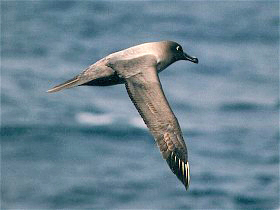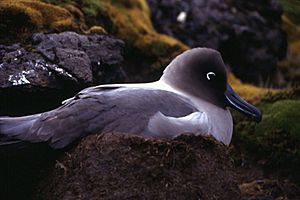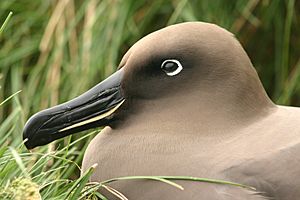Light-mantled albatross facts for kids
Quick facts for kids Light-mantled albatross |
|
|---|---|
 |
|
| in flight | |
| Conservation status | |
| Scientific classification | |
| Genus: |
Phoebetria
|
| Species: |
palpebrata
|
| Synonyms | |
|
Diomedea palpebrata |
|
The light-mantled albatross (Phoebetria palpebrata) is a type of albatross. It is also called the grey-mantled albatross or the light-mantled sooty albatross. This bird belongs to the Phoebetria group, which also includes the sooty albatross. A scientist named Johann Reinhold Forster first described this albatross in 1785. He studied a bird found south of the Cape of Good Hope.
Contents
Physical Features
Light-mantled albatrosses have special features like other Procellariiformes birds. They have tubes on their upper bill called naricorns. For albatrosses, these tubes are on the sides of the upper part of their bill.
They also have a salt gland above their nose. This gland helps them get rid of extra salt from the seawater they drink. This keeps their body's salt levels balanced. Their bills are covered with several hard plates.
These birds can also make a special stomach oil. This oil is stored in a part of their stomach. They can spray this oil out of their mouths to protect themselves from enemies. It is also a rich food source for their chicks and for adults during long flights.
Appearance
The light-mantled albatross is mostly dark brown or blackish. Its head is darker than the rest of its body. The upper parts, from its neck to its tail, are lighter grey. The lightest parts are on its back and the top of its wings.
Its coloring is sometimes compared to a Siamese cat. Around its eyes, it has thin, short grey feathers that look like a crescent moon. Its bill is black with a blue groove and a yellowish line on the lower part.
Males and females are about the same size. They are usually 79 to 89 centimeters (31 to 35 inches) long. Their wings can spread from 183 to 218 centimeters (72 to 86 inches) wide. They weigh about 2.5 to 3.7 kilograms (5.5 to 8.2 pounds).
Where They Live
The light-mantled albatross lives all around the Southern Ocean. This means they can be found in a wide circle around Antarctica. They live in the open ocean, far from land.
They range from the pack-ice near Antarctica up to about 35°S latitude. Sometimes, they are seen further north. They build their nests on several islands in the subantarctic region.
These islands include the Prince Edward Islands, Crozet Islands, Amsterdam Island, Kerguelen Islands, and South Georgia. They also breed on King George Island in the maritime Antarctic. When they are not breeding, they live entirely at sea. They search for food from the edge of the Antarctic ice to about 40°S. During breeding season, they stay closer to their nests.
Behaviour
Light-mantled albatrosses have a loud, trumpet-like voice. If they feel threatened, they will snap their bills. They might also make a deep, throaty "gaaaa" sound.
When they are trying to find a mate, they perform special aerial dances. They fly together in formation. They also make calls to each other, changing the sound by moving their heads. Unlike other albatrosses, they use their tails a lot in these displays.
Reproduction
These albatrosses usually breed in loose groups or small colonies. Sometimes, they even breed alone. They build their nests on vegetated cliff ledges or steep slopes. These spots are usually protected from strong winds.
The nest is a low mound made of peat and mud. It is about 15 to 30 centimeters (6 to 12 inches) high. The base is about 45 to 55 centimeters (18 to 22 inches) wide, with a cup-shaped hollow on top. They add some plants and grass to line the nest.
Around October or November, the female lays a single egg. If the egg is lost, they do not lay another one. Both parents take turns sitting on the egg to keep it warm. These shifts can last from a day or two up to almost a month. The egg hatches after 65 to 72 days.
Chicks hatch in December or January. It takes 3 to 5 days for a chick to fully emerge from the egg. After hatching, the parents take turns brooding (keeping warm) the chicks for about 20 days. Then, the chicks are left alone in the nest while the adults go to find food.
The adults return every 2 to 3 days to feed the chicks. They feed them by regurgitating (bringing up) food from their stomachs. The chicks stay in the nest for 140 to 170 days until they are ready to fly, usually in May or June.
Albatross pairs form strong bonds that can last for many years. They renew these bonds with special courtship displays at their breeding sites. Birds usually start breeding when they are 8 to 15 years old. After that, they breed every two years, raising a chick about every five years. They can breed until they are at least 32 years old and can live for 40 years or more.
Feeding
Light-mantled albatrosses mainly eat squid and krill. They also eat other small crustaceans and fish. Sometimes, they eat dead animals like seals, penguins, and petrels.
They sometimes feed near pilot whales and southern right whale dolphins. Occasionally, they follow ships to find food. They usually catch food on or near the ocean surface, within 5 meters (16 feet) deep. There is one record of a bird diving 12 meters (39 feet) deep for food.
Conservation
The population of light-mantled albatrosses was estimated to be about 58,000 in 1998. This number is currently going down. Scientists do not fully know all the threats or the exact population status. Because of this, the species is listed as near threatened. They live across a very large area, about 44.3 million square kilometers (17.1 million square miles).
On some breeding islands, predators like giant petrels, feral cats, and rodents can be a danger to them. At sea, they are threatened by being accidentally caught in longline fishing nets. They also face danger from eating plastic marine debris floating in the ocean, which can lead to starvation.
See also
 In Spanish: Albatros tiznado para niños
In Spanish: Albatros tiznado para niños




